Tea Horse Case Study
Case Study: Tea Horse
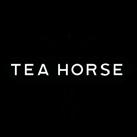

Case Study: Tea Horse

Denise Atkinson and Marc Bohémier are the co-owners of Tea Horse of Thunder Bay, Ontario, an artisanal tea company . Tea Horse is an Indigenous-owned business, which is defined as at least 51% owned and controlled by an Aboriginal person (Canadian Council for Aboriginal Business, 2022) . Together, Denise and Marc harness their love and passion for tea to offer proprietary blends of teas made from wild rice
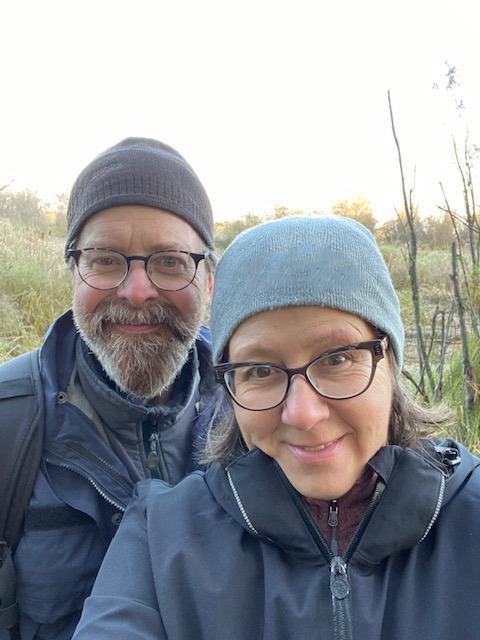
Denise was born and raised in Northwestern Ontario and is part of the Red Rock First Nation She comes from an extensive line of entrepreneurial matriarchs Her grandmother was a trapper and would sell the hides that she caught to the Hudson’s Bay Company . This deep connection to her family and their heritage inspired Denise to begin her own entrepreneurial journey with her partner Marc
Marc is from Winnipeg, Manitoba, and has completed an undergraduate degree in psychology and political studies from the University of Manitoba . He also took an Indigenous learning program at Lakehead University . Prior to starting Tea Horse, he worked as an RCMP officer across Northern Ontario, working in community-based training programs and prevention programs within First Nations communities in the region
Both are avid tea lovers and have attended many conferences and festivals, meeting other tea enthusiasts along the way They credit these experiences as the impetus to start their own journey within the tea industry .
The Red Rock Indian Band (RRIB) is an Anishinaabe-Ojibwe First Nation in Northwestern Ontario, Canada, located in what is currently known as Nipigon, Ontario . The Ojibwe (also Ojibwa), Anishinaabe, or Chippewa are among the largest groups of Native American and First Nations Peoples on the North American continent, with numerous communities across central Canada identifying as Anishinaabe (Red Rock Indian Band: Our Culture, n d .) . RRIB was once located in various locations surrounding Lake Nipigon . Before the introduction of the reserve system to this area in the late nineteenth century, these places included Jackfish Island, Gull Bay, and McIntyre Bay (English Mission Church) (Red Rock Indian Band: Early History, n .d )
As of November 2020, the total registered population of RRIB is 2,089, with 1,789 members residing off reserve (Red Rock Indian Band: About Us, n d .) According to the 2016 Census statistics, the number of community members has remained the same, with 295 on reserve . It is worth considering that Indigenous populations are frequently under-represented in national surveys .

In 2016, Anishinaabemowin was known by approximately 12% of RRIB members, with 8 .5% speaking an Indigenous language at home and 3 4% having an Indigenous dialect as their first language (Government of Canada; Indigenous and Northern Affairs Canada; Communications Branch, 2021) .

Indigenous communities across Canada had a long history of successful trade, governance, culture, and society before European settlers arrived However, as the European settlers exploited land and resources, the Indigenous Peoples living in the Lake Nipigon region were disenfranchised because of settler colonialism and the treaty process . RRIB is located within the 1850 Robinson Superior Treaty Area (Red Rock Indian Band: Our Treaty, n .d ) .
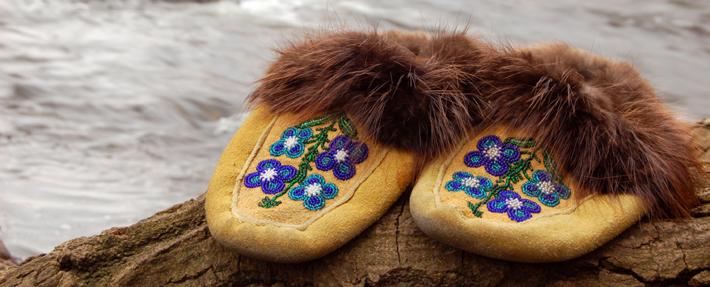
Further exploitation occurred in 1885 when the Crown surveyed 640 acres along the Nipigon River to establish a reserve land base . Indian and Northern Affairs Canada (since divided into two departments known as Indigenous Services Canada and CrownIndigenous Relations and Northern Affairs) approved RRIB’s first Chief, Chief Peter Deschamp . In 1886, the Band received 480 acres for their land base from the Canadian government It became an official “Indian Reserve” under revisions to the 1876 Indian Act in 1914 When they were forced into the Reserve System on April 15, 1886, RRIB had 166 Band members (Red Rock Indian Band: Early History, n d .)

RRIB has partnerships with academic institutions, municipal governments, and non-profit organizations These collaborations have contributed to the economic and business development of the community with focuses like skills training, tourism promotion, and research (Red Rock Indian Band: Strategic Partnership, n d .)
They are also open to new partnerships . Their website states,
“Red Rock Indian Band seeks partners who want to empower our First Nations people and build profitable businesses based on a two-way sharing of knowledge, skills, resources, and cultures . Our approach is to nurture long-standing relationships with strategic partners through mutual trust, respect, and equality . We believe this is the right way to future prosperity and success for all ” (Red Rock Indian Band: Strategic Partnership, n .d ) .
Most recently, the community announced a new partnership that solidified their position as valuable members of the regional supply chain The Red Rock Integrated Marine Supply Chain is a partnership between the BMI Group and RRIB to connect the Great Lakes seaway to existing transportation infrastructure from the Red Rock port to the Trans-Canada Highway and the Northern Community Infrastructure Corridor (BMI Group, 2023) Leveraging their location on the northern shores of Lake Superior, RRIB will approve and assist in constructing a heavy cargo port . This supply chain is critical because it will carry necessary supplies to First Nations, mining, and heavy industry sites in Northern Ontario, guaranteeing that these sectors continue to operate without incurring additional costs due to delays
The RRIB website contains a breakdown of the community’s projects and other entrepreneurial activities . It includes the following:
• Red Rock Construction Logistics and Aggregates
• Economic Development Strategic Plan Update
• Wild Rice Initiative
• The Chalet Lodge
• Lake Helen Community Gas & Variety
• Commercial Properties/Real Estate Investments
• East West Tie Transmission Project
• Aquaculture Development
• Marble Quarry
The Anishinaabe have several spiritual beliefs passed down by oral tradition under the teachings of Midewiwin (Grand Medicine Society) These include a creation story and recounting the origins of ceremonies and rituals Spiritual beliefs and rituals are crucial to the Anishinaabe because many believe that spirits guide them through life . Birch bark scrolls and petroforms (human-made rock formations in diverse shapes such as turtles, snakes, geometric motifs, and Thunderbirds) were used to pass along knowledge and information and for ceremonies . Pictographs (ancient painting sites) were also used for ceremonies (Red Rock Indian Band: Our Culture, n d )
The sweat lodge is still used during important ceremonies . These teaching lodges inform the next generations about the language and ways of the past . The traditional ways of knowing, ideas, and teachings are preserved and practiced in such living ceremonies
Among the Anishinaabe, the Teachings of the Seven Grandfathers, also known simply as the Seven Teachings or Seven Grandfathers, is a set of teachings on human conduct toward others These teachings include humility, truth, honesty, love, bravery, respect, and wisdom (Red Rock Indian Band: Our Culture, n .d ) .
Both Denise and Marc have a strong passion for tea and have spent time learning about the different origins of various teas that they enjoy Indigenous Peoples were some of the first caretakers of tea and the lands in which they grow . The tea forests in China, Taiwan, and other parts of Asia were all cared for by the Indigenous Peoples of those lands . Denise has fond memories of growing up picking blueberries with her family and using the leaves of the blueberry plants to infuse them with a pot of tea in the family home . The Anishinaabe way of life mirrors some aspects of the tea caretakers in Asia, and the idea of merging the two cultures took form . Both Denise and Marc thought it would be a natural fit to blend traditional Asian teas with Ojibwe wild rice, or manoomin .
“So, the products that we currently sell, we created our manoomin cha, which manoomin is wild rice in Ojibwe, cha being tea in many Asian cultures So, it’s like a fusion of cultures, a fusion of flavors ” - Denise

After perfecting their four blends, Denise and Marc opened a brickand-mortar shop with the hopes of sharing their love of tea with the community However, their shop was forced to close due to a lack of interest from their local community Undeterred, they pivoted to an e-commerce platform, where they have been operating since
Their goal was to offer a product that is different and unique while still honoring the people and the lands from which they come from:
“It’s this idea of a fusion of flavors with the Asian world, Western world, and Indigenous people, and that’s really the whole premise of our business was, you know, inspired by Indigenous people, honoring Indigenous people, connecting people, and just working with a really premium product.” - Marc
Tea Horse sells premium tea products that blend traditional Asian teas with wild rice . They offer four wild rice tea blends: Manoomin Chai, Manoomin Cha, Manoomin Cha dark, and a Manommiaboo Tisane blend
Tea Horse also sells various tea blends that do not contain wild rice, such as earl grey and breakfast teas, masala chai, bancha, and tisane herbal tea blends . However, their wild rice recipes are what set them apart from other tea producers They are one of the only producers of wild rice tea products in the industry today .
“We quickly found out that no one in the tea world and no one in the wild rice world was roasting wild rice and combining it with tea. So, it’s quite innovative. And when you consider how ancient both types of foods are, it’s a cool feeling to know that you’ve developed something so unique.” - Denise
Apart from their roasters and packaging, Denise and Marc run the business out of their home . They have moved exclusively to an e-commerce platform and have slowly transitioned from focusing their efforts on B2C (business to consumers) to B2B (business to business) relationships .
Tea is a part of many Canadians’ daily routines, steeped in tradition and numerous benefits As the second most consumed beverage after water, tea is widely recognized as a natural and healthy drink crafted from sustainable resources (Mordor Intelligence, n d .) . Although there is a wide range of options available in retail and service markets, Canadian tea drinkers are continually searching for new, innovative, and highquality products that fit into their lifestyles . In response, companies are striving to meet the evolving demands of consumers and continue the growth of this flavourful market through new launches of blends (Mordor Intelligence, n .d )
Creating variations of tea requires an understanding of many factors including the origin of the ingredients and the techniques used in harvesting and processing them (Zavatto, 2011) These influences play a critical role in determining the aromas and flavours of tea, as well as how the final results are perceived by consumers (Zavatto, 2011) . For businesses looking to innovate new products, perfecting flavours can be a complex and time-consuming process (Tea & Coffee Trade Journal, 2016) This process involves tasting and blending several ingredients to explore diverse flavour profiles, which can take months to refine . In some cases, new flavours require different sets of manufacturing procedures, ranging from hand-blending and roasting techniques to the use of various large-scale equipment (Tea & Coffee Trade Journal, 2016) .
Despite its complexity, the growth of the industry has pushed many premium tea innovators to the forefront of the market With its considerable growth over the years, the global tea industry has reached a worth of USD 16 .59 billion in 2023, with USD 1 57 billion attributed to the Canadian market (Statista, n d ) With this, the market is projected to experience a compound annual growth rate (CAGR) of 3 .29% from 2023 to 2025 (Statista, n d .) .
Despite the recent challenges posed by the COVID-19 pandemic, the tea industry was able to adjust through market disruptions by embracing the rise of e-commerce (Duckler, 2021) . The COVID-19 pandemic also prompted a heightened awareness among Canadians regarding health and wellness (Kiel, 2022) This recognition led to a surge in demand for premium teas through online channels, particularly herbal varieties that offer immuneboosting benefits in addition to their traditional comforting taste (Kiel, 2022) Due to this rise, small businesses had to quickly adapt to meet the changing needs of their customers and ensure that tea enthusiasts could still access their favourite blends while keeping safe . The increased adoption of e-commerce provided a vital lifeline for the tea industry as businesses sought stability during this challenging time (Duckler, 2021) .
The growth of online sales provided tea businesses with increased opportunities to broaden their horizons . The United States (U S ) is Canada’s strongest trade partner, and many businesses have sought to expand their reach to this country (Office of the United States Trade Representative, n d .) Figure 1 demonstrates the exponential growth in exports from Canada to the U .S . in 2022 alone The U S is known for its large consumer base and strong economy (Office of the United States Trade Representative, n .d .) For businesses looking to enter the U S market, the benefits of tariff-free trading made possible through the North American Free Trade Agreement (NAFTA) and the Canada-United States-Mexico Agreement (CUSMA) and the increasing ease of cross-border trade facilitated by advancements in technology and logistics are compelling incentives (Government of Canada, 2022) The U .S is also a significant player in the tea industry, ranking fourth behind Japan, India, and China (Statista, n d .) .
When considering this type of expansion, tea businesses must decide on their approach to selling Businesses can focus on businesses-to-consumer (B2C) or business-to-business (B2B) selling, or both simultaneously (Forbes, 2023) . B2C involves selling products directly to individual customers, while B2B consists in selling products to other businesses that will use them as part of their products or services (Forbes 2023) These two methods of selling carry complex differences in terms of supply needs, marketing strategies, and distribution (Herman, 2017) Determining which approach to adopt can depend on several factors, including the business’s resources, target market, and goals for expansion (Forbes, 2023)
To successfully expand into this market, tea businesses must be well-versed in navigating exporting procedures, building new relationships with distributors and representatives, and investing in marketing and branding efforts to meet the demands of this prosperous market (Government of Canada, 2020) By growing and leveraging their expertise, small businesses can have a significant impact on expanding their business through trade, further solidifying their position in the global economy
To create a niche, premium tea products require large investments, especially when growing a customer base Although changing the status quo can be exciting, it requires careful planning and a willingness to adapt to changes when needed . It also involves going up against larger players in the market, who have significant resources and established brand recognition Corporations like Hain Celestial Group Inc , Bigelow Tea Inc ., and Traditional Medicinals are some of the largest global tea distributors in the market (Mordor Intelligence, n d .) Brands like these can make it difficult for small tea businesses to compete, especially in terms of pricing and marketing . However, despite the challenges, there are many opportunities for success in the Canadian tea market and beyond Through strategic business planning and cultivating partnerships with like-minded individuals, businesses can leverage their strengths to provide high-quality products that set them apart from others for a variety of consumers
Figure 1 illustrates Canada’s exports to the United States, represented in billions of dollars ($), between 1998 and 2022 . The line chart indicates a general upward trajectory, apart from the downturns of the Great Recession (2008-2009) and the COVID-19 pandemic (2020-2022) The chart depicts a sharp increase in exports in 2022
Trading Economics . (n .d ) . Canada Exports to United States Retrieved March 31, 2023 . https://tradingeconomics .com/canada/exports/united-states
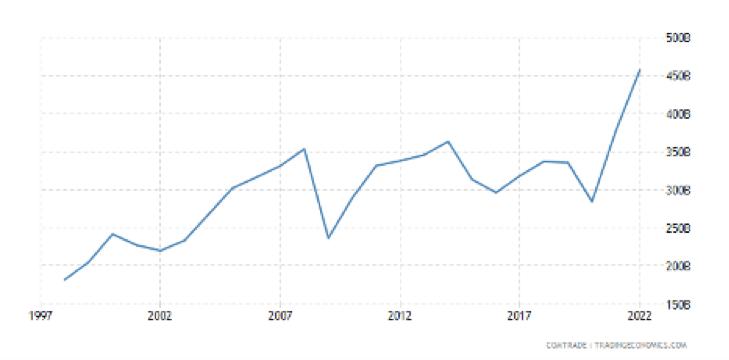

Among the B2B partnerships that Tea Horse successfully established was their collaboration with David’s Tea, a Canadianowned retail company that sells tea products and paraphernalia David’s Tea reached out to Denise and Marc to develop a specialty tea blend named Manoomin Maple .
It was also an opportunity for Denise and Marc to give back to the communities that their tea blends represent A percentage of sales of Manoomin Maple would be donated to the David Suzuki Institute for Indigenous Reconciliation programming . Both Denise and Marc credit their unique wild rice tea blends as the reason for the partnership .
“The reason David’s Tea came to us or approached us was that their first question was: ‘We’ve never heard of wild rice tea,’ and we went: ‘That’s because we’re the only people that ever made it.’
So, it was their interest in the wild rice and the how, like, what did we do with wild rice?
And so we told them it was this inspiration from the Japanese Genmaicha. So, from there, it was their interest in what we were doing.”
 – Denise
– Denise
By every measure, the collaboration with David’s Tea was a success . After its release to the public, it became the number one seller on David’s Tea’s e-commerce platform for approximately three weeks .
“I think one of the key successes was being recognized by an international tea company that we’re doing something innovative and creative, and they approached us We shared a North American tea award with them on our sustainability for the blend that we partnered with . That’s been a huge success for us .” – Marc
Tea Horse had the opportunity to be selected by the Trade Commissioner of Canada to attend trade missions in the U .S

This opportunity has allowed Denise and Marc to establish relationships in new markets and strengthen their relationships with Indigenous communities and businesses in the U .S . When it comes to building B2B relationships with Indigenous communities, both Denise and Marc recognize the importance of the traditional ways in which Indigenous Peoples developed and nurtured relationships
“You don’t just go into an organization, into another Nation, for instance, because we’re trying to develop relationships with U.S. Indigenous Nations and talk at them. We’re here to build a relationship. Let’s sit down, let’s talk, and let’s see what you need. Be very respectful and follow their protocols, follow Indigenous protocols.” – Marc
For both Denise and Marc, this is an important part of how they conduct their business and establish relationships with potential partners and customers . They feel it is important to separate themselves as much as possible from the Western, Eurocentric ways of conducting business For them, it’s a way to continue to honour Denise’s heritage
“It’s more than just business, it’s a spiritual connection, and it’s not just a land-based connection; it’s place-based For Indigenous people, it’s about the place Where there’s power, where there’s spirituality is because it’s from that specific place where they reside . Teachings come from these places So, we need to go there in person and sit down and talk and get to know each other . And we think that’s a really great way of doing business ”- Marc
While this may add additional costs and travel burdens, the value of connecting with Indigenous communities in the U S has been a rewarding experience for both Denise and Marc
“The rewards are we’re making these connections and reconnecting with people that we need to be connected with to help our business grow and help their businesses and nations thrive.”- Marc

Being the first to do something can be extremely rewarding and can also come with its own set of challenges Being the first producers of wild rice tea blends, there is no blueprint available to follow when it comes to developing the perfect recipe It took Marc quite some time to figure out the correct roasting method and ingredients for their tea blends . When Tea Horse started, they were selling in small batches, which allowed them to keep their recipes and production methods simple . Scaling up and selling large volumes has proven to be quite tricky, mainly because there is no roaster in Canada specializing in wild rice Most roasters specialize in coffee or grains
When you have an innovative product that you believe in, sometimes you need a little persistence to get the product to market It has taken some time, but Tea Horse is now in a position where it can scale its business and continue to offer its products
“If you come up with something innovative, it is hard to scale because it’s not an off-the-shelf purchase . And that’s what we found out We’ve worked with a lot of different people that helped us out, but again, it’s massive money to get into some kind of roasting that makes sense to us Like from a hundred grams to a thousand kilos, it’s too big of a jump, and we’re navigating that part of it .
Tea Horse has plans to expand its business into the U .S ., but one of the challenges that they have faced is related to packaging its products . There are different sets of laws in Canada and the U S . when it comes to the packaging and labeling of your products .
For example, Tea Horse had to consider the nutritional information that is included in its packaging The challenge that Denise and Marc faced was finding a proper analysis of the roasted wild rice that they use in their products and could include on their packaging according to the U .S . Food and Drug Administration (FDA) guidelines They have had to spend time and effort to find an agency that can analyze the wild rice to ensure it meets the regulations for the U .S . market Denise and Marc considered opening an office in the U .S .; this way, they would be able to import the ingredients directly to the U S . rather than exporting from Canada to the U S .
“Getting into a different country. Well, again, export rules, how do we export things? Should we source? Should we start sourcing wild rice out of the U.S. so we don’t have to worry about export? Should we set up a physical presence in the U.S., like an office space somewhere? Is it easier to export from Canada to the U.S., or is it easier to just buy wild rice and our tea products and have them created, blended, and roasted in the U.S.? These are really complex challenges.” - Marc
Tea Horse started out dealing with B2C transactions, but that came with its own set of challenges It can be quite costly to ship smaller product shipments compared to shipping larger volumes of products
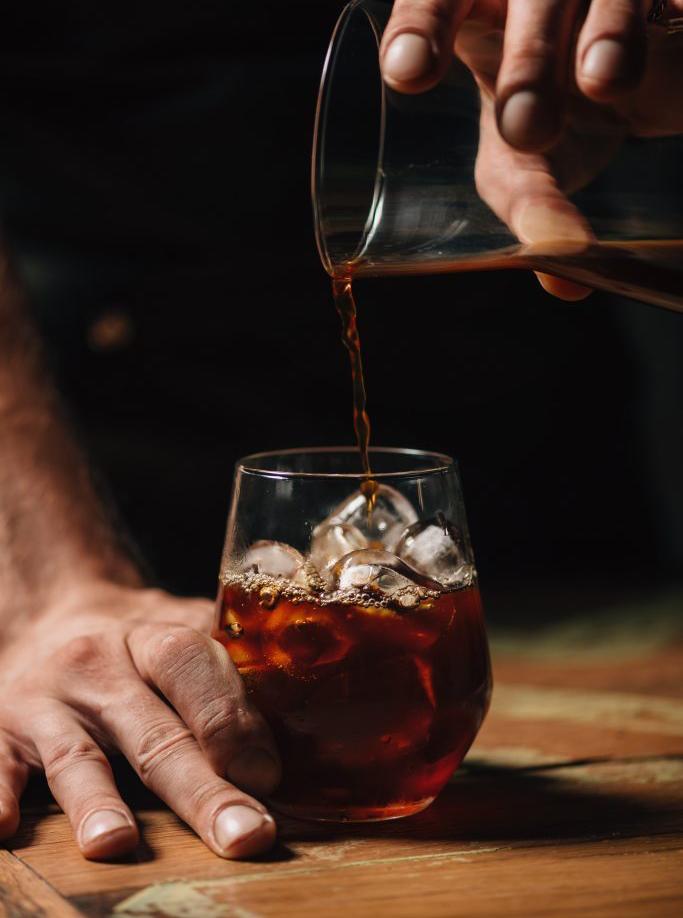
“I think the other thing too is with e-commerce, where it’s a challenge too is when you sell B2C, so business to client or business to consumer, there’s a lot of costs associated to just shipping.” – Denise
From there, Denise and Marc decided to pivot once more and focus their attention on establishing relationships with larger orders and businesses or B2B clients While scaling their business was an initial challenge, now they can sell larger volumes and have begun to seek those partnerships more than they have in the past .
“So, business-to-business, because we feel, instead of packaging three or four packs of tea, we might get an order for like 900 or 400 or a hundred or 30. And, you know, that’s a lot more cost-effective. Well, as far as shipping, we could ship 25 packs of tea for the same price that it costs to ship three packs to the consumer. So that’s why B2B is what we’re really focusing on now.” – Marc
With these new opportunities comes the likelihood of Tea Horse finding a new customer base and market for its products while staying true to its core supporters

For Denise, having her Indigenous heritage incorporated into Tea Horse’s products is especially important to her She was taught to honour the gifts that we receive from the earth and to recognize the importance of these gifts and the roles that they can play in our everyday lives . She tries to incorporate her Indigenous culture into all aspects of the business
“I want that to come across in all our marketing, our branding, I guess. Because, like I say, I am a proud Indigenous woman who grew up with strong Indigenous role models, matriarchs, and you know, my grandfather, my uncles, as well as the matriarchs.” – Denise
Tea holds a special place in Denise’s life and can be traced back to her family’s connection to tea She wants this same connection to be felt by those who consume Tea Horse teas .
“I have a very supportive family where tea was included as part of our social interactions . We always had a pot of tea I just think tea is really important Tea is food, and tea — it’s family, it’s communal, it’s just warmth . It’s like a big hug ” – Denise
Denise’s connection to her heritage and to tea does not stop there; they try to incorporate other Indigenous beliefs into their business decisions . They honour traditional Indigenous practices in a variety of ways Denise and Marc are respectful, open, and considerate of other First Nations traditions and try to incorporate these into the business relationships that they have established .
“Being respectful of people, being respectful of the gifts that we receive, the ingredients, like everything is a gift, and we really have to honour relationships, build relationships. When it comes to developing B2B customers, it’s all about relationship building.” – Marc
For both Denise and Marc, it can often be traced back to a deeper connection amongst Indigenous Peoples that they hope to continue to honour and cultivate . They have had the opportunity to visit a variety of Indigenous communities across the U S and Canada, learning much along the way .
“We have learned about the similarities between Indigenous peoples and how we’ve had, not we, but Indigenous people have had so many of the similar struggles and challenges since colonization hit their communities ” – Denise
They hope to use Tea Horse as an avenue to continue to honour the long-standing bonds amongst Indigenous communities that have existed since time immemorial .
Both Denise and Marc offer practical advice for those who may want to start their own entrepreneurial journey:
Having a business plan that you can turn to when things change is particularly important You may need to revisit it, and the document will change as your goals change .
“It’s really important to have it written down and have an idea of what you need to know: what your expenses are going to be, who your target market is, what your goals are — short-term, long-term, specific goals, tangible goals.” –
DeniseFinding people who believe in you and whom you believe in is crucial . Surrounding yourself with people you can count on and turn to for advice can be helpful when problems arise
People are often willing to share their advice when asked, and Denise and Marc have established great relationships with suppliers, government representatives, bankers, Indigenous Peoples and non-Indigenous people, and family and friends that they can turn to

“If you surround yourself with people that you can trust, whether they be suppliers, good friends that will give you a piece of straight advice, other businesspeople that will give you the straight goods on what’s happening. And they’ll be honest with you. Like when we got into the tea business, we were told by one of our key suppliers this is a tough business.” –
 Marc
Marc
Lastly, networking is crucial to growing your business However, one must be willing to put the effort into following up with connections People you meet are not likely to reach out to you, and it is important to be proactive in following up on leads and with the connections you may meet along the way .
“Don’t expect people to come to you. You must follow up, and that’s so important. If you follow up once, twice, three times, keep doing it.”
– DeniseBMI Group . “First Nations heavy-cargo port partnership in Northern Ontario ” News Wire March 7, 2023 . https://www .newswire .ca/news-releases/first-nations-heavycargo-port-partnership-in-northern-ontario--836571995 .html
Duckler, D (2021, July 7) . Post Pandemic: Is the Tea Industry Ready for the Spotlight? World Tea News Retrieved February 1, 2023 https://www .worldteanews com/ issues-trends/post-pandemic-tea-industry-ready-spotlight
Forbes . (2023, January 10) . Five Challenges of Doing B2B in a B2C Company Retrieved February 1, 2023 https://www forbes com/sites/esade/2023/01/10/fivechallenges-of-doing-b2b-in-a-b2c-company/?sh=33d951463e36
Government of Canada (2020, July 7) Exporting to the United States – Entering your chosen U S market . Retrieved February 4, 2023 https://www tradecommissioner .gc ca/guides/us-export_eu/141451 aspx?lang=eng
Government of Canada; Indigenous and Northern Affairs Canada; Communications Branch (2021, February 15) . First Nation Profiles https://fnp-ppn aadnc-aandc gc ca/FNP/Main/Search/FNLanguage .aspx?BAND_NUMBER=193&lang=eng
Government of Canada (2022, September 13) Canada’s State of Trade 2019 Retrieved March 31, 2023 https://www .international .gc ca/gac-amc/publications/ economist-economiste/state_of_trade-commerce_international-2019 aspx?lang=eng#Section3 2 .3
Herman, Z (2017, August 9) The Best of Both Worlds: Running a B2B and B2C Online Business Simultaneously Forbes . Retrieved February 1, 2023 https://www forbes com/sites/theyec/2017/08/09/the-best-of-both-worlds-running-a-b2b-and-b2c-online-business-simultaneously/?sh=6dbfa113ce03
Kiel, A (2022, March 26) The Pandemic Spurs an Ever-increasing Demand for Wellness Teas Tea & Coffee Trade Journal Retrieved February 8, 2023 https://www . teaandcoffee net/feature/30440/the-pandemic-spurs-an-ever-increasing-demand-for-wellness-teas/
Mordor Intelligence (n d ) North American Tea Market – Growth, Trends, Forecasts (2023-2028) . Retrieved February 4, 2023 https://www mordorintelligence com/ industry-reports/north-america-tea-market
Office of the United States Trade Representative (n d .) Economy & Trade Retrieved February 11, 2023 https://ustr gov/issue-areas/economy-trade
Red Rock Indian Band: About Us . (n d ) . http://rrib ca/about-us/
Red Rock Indian Band: Early History (n d .) http://rrib ca/about-us/early-history/
Red Rock Indian Band: Our Culture (n d ) http://rrib .ca/our-culture/
Red Rock Indian Band: Our Treaty (n .d ) http://rrib ca/about-us/our-treaty
Red Rock Indian Band: Strategic Partnership (n d .) http://rrib ca/economic-development/strategic-partnership/
Statista (n d ) Tea – North America . Retrieved February 1, 2023 . https://www statista com/outlook/cmo/hot-drinks/tea/north-america
Statista (n d .) Tea – United States Retrieved February 1, 2023 https://www statista .com/outlook/cmo/hot-drinks/tea/united-states
Tea & Coffee Trade Journal (2016, October 13) The Art of Tea Tasting & Blending Retrieved March 31, 2023 https://www .teaandcoffee .net/feature/906/art-teatasting-blending/
Zavatto, A . (2011) . Tea Blending . Imbibe Magazine – Liquid Culture . Retrieved March 31, 2023 . https://imbibemagazine com/tea-blending/
Land Acknowledgement
Humber Institute of Technology and Advanced Learning and the Canadian Council for Aboriginal Business is on the treaty lands and traditional territory of the Mississaugas of the Credit and homeland of Anishinaabe, Haudenosaunee, and the Wendat peoples and is now home to many diverse First Nations, Inuit and Métis peoples . We also acknowledge that Toronto is covered by Treaty 13 with the Mississaugas of the Credit
Humber Institute of Technology and Advanced Learning
Audrey Wubbenhorst, Professor and Principal Investigator
James Henebry, Research Project Manager
Patrycja Szkudlarek, Research Assistant
Canadian Council for Aboriginal Business:

Andy Avgerinos, Research Project Manager
Lucas Alexiou, Research Associate
Cody Lewis, Research Coordinator
The research team would like to thank Denise Atkinson and Marc Bohémier of Tea Horse who generously shared their time, experiences, and knowledge throughout the development of this case study
Suggested Citation
Wubbenhorst, A , Henebry, J , & Szkudlarek, P . (2023) . Indsights - A Window into the Indigenous Economy: A Case Study on Tea Horse (pp . 1–20) Toronto, Ontario: Humber Institute of Technology and Advanced Learning . Retrieved from www .indsights .ca
Case Study: Tea Horse